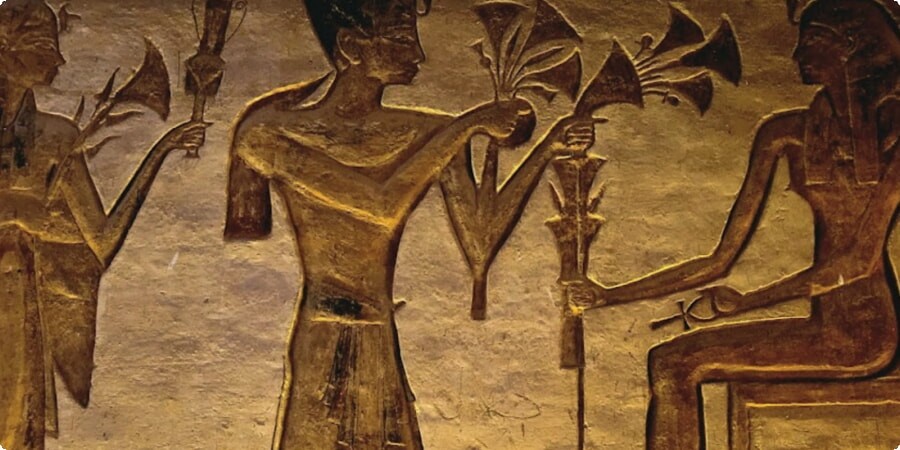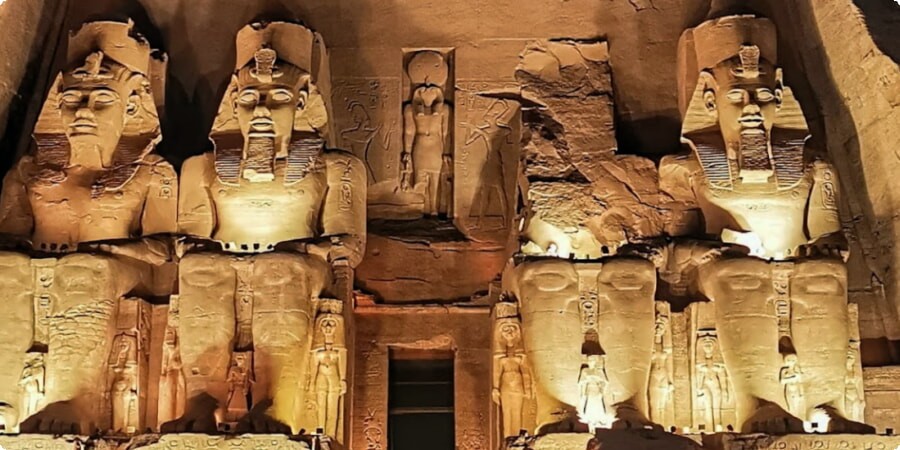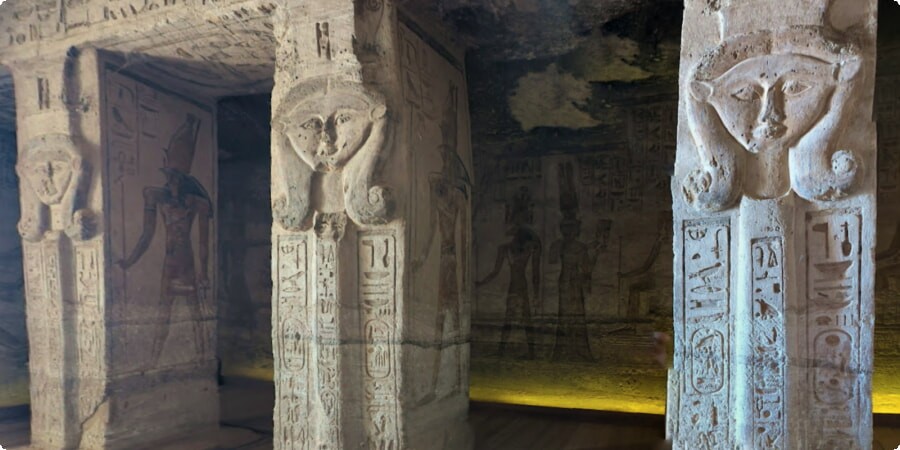Abu Simbel: Temples of the Pharaohs on the Banks of the Nile
Nestled along the banks of the majestic Nile River lies one of Egypt's most iconic treasures: Abu Simbel. This ancient archaeological site, renowned for its magnificent temples carved into the cliffs, stands as a testament to the grandeur and ingenuity of ancient Egyptian civilization. As the sun rises over the horizon, casting its golden rays upon the colossal statues of pharaohs and gods, visitors are transported back in time to an era of divine rulers and sacred rituals.
Construction and Purpose:
Abu Simbel's story begins over 3,000 years ago during the reign of the mighty Pharaoh Ramses II, also known as Ramses the Great. Eager to demonstrate his power and devotion to the gods, Ramses embarked on an ambitious construction project to create two temples dedicated to himself and his beloved queen, Nefertari.
The Great Temple of Abu Simbel, dedicated to the deified Ramses II himself, stands as a monumental tribute to the pharaoh's greatness. Its facade is adorned with four colossal statues of Ramses, each reaching a towering height of over 20 meters (66 feet). These imposing figures, seated majestically on thrones, are a testament to Ramses' divine status and military prowess.
The Great Temple of Ramses II:
Venturing into the depths of the Great Temple, visitors are greeted by a series of awe-inspiring halls and chambers adorned with intricate hieroglyphs and vibrant murals. These elaborate reliefs depict scenes of Ramses' victorious military campaigns and religious rituals, immortalizing the pharaoh's achievements for eternity.
One of the most striking features of the Great Temple is the phenomenon known as the "Solar Alignment." Twice a year, on February 22nd and October 22nd, the sun's rays penetrate the temple's inner sanctum and illuminate the statues of Ramses and the gods seated within. This celestial event symbolizes the pharaoh's eternal bond with the sun god Ra and serves as a reminder of his divine lineage.

For those eager to embark on their own journey of discovery to Abu Simbel, a visit to Sharm El Sheikh serves as an ideal starting point. Situated along the picturesque shores of the Red Sea, Sharm El Sheikh offers a gateway to the wonders of ancient Egypt. Book your car rental in Sharm El Sheikh here and begin your adventure to Abu Simbel, where the sands of time reveal the secrets of Egypt's past.
Learn more about Abu Simbel on Wikipedia
Explore the location of Abu Simbel on Google Maps
The Temple of Hathor and Nefertari:
While the Great Temple of Ramses II rightfully commands attention with its grandeur, the nearby Temple of Hathor and Nefertari is equally deserving of admiration. Dedicated to the goddess Hathor, often associated with love, music, and motherhood, and Queen Nefertari, beloved wife of Ramses II, this temple offers a more intimate and feminine counterpart to its grand neighbor.
The facade of the Temple of Hathor and Nefertari features six colossal statues, four depicting Ramses II and two depicting Nefertari herself. These statues stand as a testament to the pharaoh's devotion to his queen, immortalizing her alongside him for eternity. The interior of the temple is adorned with exquisite reliefs and paintings depicting scenes of royal worship and homage to the gods.

Relocation and Preservation:
In the 1960s, the temples of Abu Simbel faced an unprecedented threat. The construction of the Aswan High Dam and the resulting formation of Lake Nasser threatened to submerge these ancient wonders beneath the waters of the Nile forever. In a remarkable feat of engineering and international cooperation, the temples were painstakingly dismantled and relocated to higher ground, preserving them for future generations.
Today, visitors to Abu Simbel can marvel at not only the temples themselves but also the incredible achievement of their relocation. The temples now stand proudly on the shores of Lake Nasser, a testament to human ingenuity and the enduring legacy of ancient Egypt. Ongoing efforts continue to ensure the preservation of Abu Simbel and its priceless artworks, safeguarding them from the ravages of time and tourism.

For those planning to explore the wonders of Egypt beyond Abu Simbel, renting a car offers the flexibility and freedom to journey at your own pace. Whether you're embarking on a road trip along the Nile or venturing into the desert, a rental car provides the perfect mode of transportation. Book your car rental in Egypt here and embark on an unforgettable adventure through the land of the pharaohs.
Symbolism and Religious Significance:
Abu Simbel's temples are not merely architectural marvels but also repositories of profound symbolism and religious significance. Central to their design is the concept of divine kingship, wherein the pharaoh is not only a political ruler but also a divine intermediary between gods and humans.
The alignment of the temples with the sun, particularly during the biannual phenomenon of the Solar Alignment, underscores this divine connection. On the mornings of February 22nd and October 22nd, the sun's rays penetrate the inner sanctum of the Great Temple and illuminate the statues of Ramses II and the gods seated within. This solar event symbolizes the pharaoh's divine association with the sun god Ra and his role as the earthly embodiment of divine power.
The temples also serve as sacred spaces for religious rituals and ceremonies, where priests and devotees would come to pay homage to the gods and seek divine favor. The intricate reliefs and inscriptions adorning the walls depict scenes of worship, offering insight into the religious beliefs and practices of ancient Egypt.

Visiting Abu Simbel Today:
Today, Abu Simbel stands as one of Egypt's most iconic and visited tourist attractions, drawing visitors from around the world to marvel at its ancient splendor. Situated in the southernmost reaches of Egypt, near the border with Sudan, Abu Simbel is accessible by road, air, and even by Nile cruise.
For those embarking on a journey to Abu Simbel, Aswan serves as the primary gateway to this ancient wonder. From Aswan, visitors can choose from a variety of transportation options, including organized tours, private taxis, and even domestic flights to the nearby Abu Simbel Airport.
Upon arrival, visitors are greeted by the imposing facades of the temples, which stand as silent sentinels guarding the secrets of Egypt's past. Guided tours offer insight into the history and significance of Abu Simbel, allowing visitors to explore the temples' interior and marvel at their intricate carvings and paintings.
As you stand in the shadow of these ancient monuments, you can't help but feel a sense of awe and wonder at the ingenuity of the ancient Egyptians who built them. Abu Simbel is more than just a tourist destination; it's a living testament to the enduring legacy of one of history's greatest civilizations.